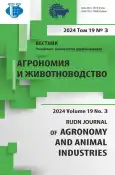Automatic milking and incidence of mastisis in cows
- Authors: Mikhalev V.I.1, Zimnikov V.I.1
-
Affiliations:
- All-Russian Veterinary Research Institute of Pathology, Pharmacology and Therapy
- Issue: Vol 19, No 3 (2024)
- Pages: 507-516
- Section: Veterinary science
- URL: https://journal-vniispk.ru/2312-797X/article/view/315804
- DOI: https://doi.org/10.22363/2312-797X-2024-19-3-507-516
- EDN: https://elibrary.ru/CJUBEF
- ID: 315804
Cite item
Full Text
Abstract
One of the main aspects of obtaining milk of high sanitary quality is functioning of milking equipment. Currently, the main volume of dairy products produced comes from dairy complexes equipped with milking parlors with automatic milking system. However, as practice shows, in the automatic milking system, settings may fail and be incorrectly set, leading to negative effect on mammary gland of cows. Hence, the goal of the research was to study the effect of settings of automatic milking equipment (vacuum in teat chamber, minimum milk flow when removing milking machines) on functional state of mammary gland of high-yielding lactating cows. The experiments were carried out in two milking parlors. At milking parlor 1, there was no maintenance of milking machine for three years. At milking parlor 2, there was regular maintenance with testing of each milking machine. It was established that with regular maintenance (milking parlor 2), the “milking vacuum” was in the range of 37…39 kPa, in the main pipe - 40…42 kPa, i. e. the difference was no more than 2-3 kPa. Insufficient vacuum in teat chamber (34…36 kPa) resulted in 1.6-2.0-fold increase in duration of milking, 2.5-4.0-fold increase in number of cows with udder irritation, 3.0-4.2-fold increase in incidence of subclinical mastitis, 3.2-11.8-fold increase in incidence of clinical mastitis, 2.0-3.2-fold increase in number of somatic cells in collected milk. Increase in minimum milk flow up to 450…500 g/min after turning off the milking machine ensures 3.9-fold reduction in the number of cows with udder irritation, 4.1-fold reduction of cows with subclinical mastitis, 21.2-fold reduction of cows with clinical mastitis, and 4.2-fold decrease in the number of somatic cells in collected milk (145.5 thousand/ml that corresponds to premium milk).
Keywords
About the authors
Vitaliy I. Mikhalev
All-Russian Veterinary Research Institute of Pathology, Pharmacology and Therapy
Author for correspondence.
Email: mikhalevvit@yandex.ru
ORCID iD: 0000-0001-9684-4045
SPIN-code: 5252-8718
doctor of veterinary sciences, chief researcher, sector of bovine reproductive organ diseases, department of experimental therapy
114b Lomonosov st., Voronezh, 394087, Russian FederationVitaliy I. Zimnikov
All-Russian Veterinary Research Institute of Pathology, Pharmacology and Therapy
Email: ivanovich.vitalick@yandex.ru
ORCID iD: 0000-0002-6371-7143
SPIN-code: 3281-7694
candidate of veterinary sciences, senior researcher, sector of bovine mammary gland diseases, department of experimental therapy
114b Lomonosov st., Voronezh, 394087, Russian FederationReferences
- Inzaghi V, Zucali M, Thompson PD, Penry JF, Reinemann DJ. Changes in electrical conductivity, milk production rate and milk flow rate prior to clinical mastitis confirmation. Ital J Anim Sci. 2021;20(1):1554—1561. doi: 10.1080/1828051X.2021.1984852
- Simonov GA, Nikiforov VE, Serebrova IS, Ivanova DA, Filippova OB. The influence of robotic milking on the quality of milk. Science in the Central Russia. 2020;(2):117—124. (In Russ.). doi: 10.35887/2305-2538-2020-2-117-124
- Filippova OB, Kiyko EI. Economic aspects of violation of the rules of machine milking in industrial milk production. Science in the Central Russia. 2013;(6):72—75. (In Russ.).
- Klimov NT, Mikhalev VI, Nezhdanov AG, Pershin SS. Technological parameters of the mechanical milking and the incidence of mastitis in cows. Veterinary Medicine. 2013;(8):37—39. (In Russ.).
- Konopeltsev IG, Shulyatiev VN. Vospalenie vymeni u korov [Inflammation of the udder in cows]. Kirov; Saint Petersburg; 2010. (In Russ.).
- Ebrahimi M, Mohammadi-Dehcheshmeh M, Ebrahimie E, Petrovski KR. Comprehensive analysis of machine learning models for prediction of sub-clinical. Comput Biol Med. 2019;114:103456. doi: 10.1016/j.compbiomed.2019.103456
- Tyapugin EA, Tyapugin SE, Simonov GA, Uglin VK, Nikiforov VE, Serebrova IS. Comparative evaluation of technological factors, affecting the production and the quality of milk, various technologies of milking. Doklady Rossiiskoi akademii sel’skokhozyaistvennykh nauk. 2015;(3):50—53. (In Russ.).
- Grebenkin DA. Mastitis under control. Step 1. Control of the milking equipment. Bio. 2015;(4):47—49. (In Russ.).
- Bobbo T, Ruegg PL, Stocco G, Fiore E, Gianesella M, Morgante M, et al. Associations between pathogen-specific cases of subclinical mastitis and milk yield, quality, protein composition, and cheese-making traits in dairy cows. J Dairy Sci. 2017;100(6):4868—4883. doi: 10.3168/jds.2016-12353
- Serebrova IS, Uglin VK, Nikiforov VE. Production and quality of milk under various milking technologies and maintenance methods. Farm Animals. 2016;(2):10—12. (In Russ.).
- Tse C, Barkema HW, DeVries TJ, Rushen J, Pajor EA. Effect of transitioning to automatic milking systems on producers’ perceptions of farm management and cow health in the Canadian dairy industry. Journal of Dairy Science. 2016;100(3):2404—2414. doi: 10.3168/jds.2016—11521
- Besier J, Bruckmaier RM. Vacuum levels and milk flow dependent vacuum drops affect machine milking performance and teat condition in dairy cows. Journal of Dairy Science. 2016;99(4):3096—3102. doi: 10.3168/jds.2015-10340
- Klimov NT, Zimnikov VI. Veterinary-technological aspects of protection of mammary gland health in cows and milk quality decrease. Dairy Industry. 2015;(10):69—70. (In Russ.).
- Alhussien MN, Dang AK. Milk somatic cells, factors influencing their release, future prospects, and practical utility in dairy animals: An overview. Vet World. 2018;11(5):562—577. doi: 10.14202/vetworld.2018.562-577
- Shabunin SV, Klimov NT, Nezhdanov AG. Significance of physiological and technological factors in development of mastitis in lactating cows. Reproduction in Domestic Animals. 2017;52(S3):133. doi: 10.1111/rda.13026
Supplementary files










